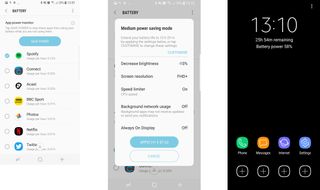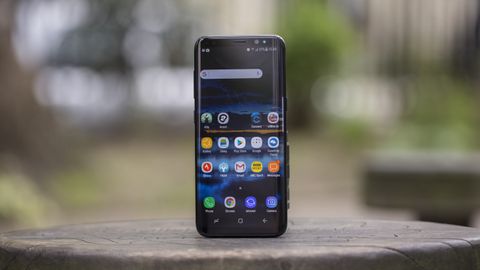Why you can trust TechRadar
- Battery will easily last a day in most use cases
- Excellent power-saving modes
- Fast and wireless charging both work well
- The Galaxy S8 Plus battery is far superior
The battery life of the Samsung Galaxy S8 was always likely to be pretty good, and in our tests it proved to be just that. Let's walk you through some of the features that are on offer first though, before getting into the numbers.
The Galaxy S8 has a 3000mAh battery – one suspects this would have been larger were it not for the Galaxy Note 7 fires and explosions forcing Samsung to play it safe with the S8. However, given that's the same power pack as seen in the S7, and larger than the one in the S6, it should last just fine.
On top of that Samsung has also thrown in fast and wireless charging (using any popular wireless charging standard around), and you've got loads of ways to make sure you don't run out of power with this handset.

In terms of real-world usage, the battery life on the Galaxy S8 is hard to define... 'better than acceptable' would be a good way to put it. Under hard use things would get dicey towards the end of the day, but in more sedate conditions it's easily going to get you home to a charger.
For instance, we were left with over 60% on an average day by lunchtime (when unhooked from a charger at 6am), and performance like that breeds confidence in the power pack.
That's fine for most people, and it doesn't feel slippery – but it's not as good as the Galaxy S7 Edge from last year, for instance. Don't take that as a reason to not buy this phone, but don't see battery life as a standout feature either – you'll basically not have to worry about battery life on the Galaxy S8.
The fast charging, although not improved since last year, is miles better than on any phone that arrived in 2015 or earlier. We started charging the S8 from completely flat, and within five minutes it had reached 7% – good enough to make it home on a commute.
We tested the rapid charge from dead a couple of times, and found that the Samsung Galaxy S8 can go from no power at all to full in around 80 minutes, with a linear charging curve – so it doesn’t taper off at the end, it's more of a consistent power top-up.
It was 7% after five minutes, 45% at 35 minutes and 72% at 55 minutes, before ending up at 100% on 82 minutes.
We ran our standard battery run-down test, charging the phone to 100% and then running a 90-minute full HD video at maximum brightness, with various apps syncing wirelessly in the background, to see how much the battery drained.
The Samsung Galaxy S7 Edge managed a drop of just 14%, but the Galaxy S8 dropped 19% in the same time – and that was with the resolution set to only Full HD. Set to Quad HD (the highest resolution) the drop was 23% – not a good number compared to the best performers on the market.
That's quite a lot lower than the Samsung Galaxy S8 Plus' scores when it comes to running the same test: it scored 8% at Full HD, and 11% at QHD - which is a very impressive score indeed.

However, before you read too much into that result, it should be noted that the Galaxy S8 offers higher brightness than nearly any other smartphone around, and when the display is cranked to full it’s actually a bit too bright, with Samsung actually warning about using it at this brightness for too long.
Crank it down to a more palatable level – and the auto-brightness is excellent here – and you’ll get a much longer time using the screen in most conditions.
(For comparison's sake, we re-ran the battery test with auto-brightness on in mixed lighting conditions, and the drop was only 14%... that still hints that the battery isn't as long-lasting as the Galaxy S7, but there are more pixels to power thanks to the longer display).
But the extra brightness is great when you're outdoors, and makes everything wonderfully legible.
The battery interface hasn’t been improved hugely since the Galaxy S6 or S7, with the same information telling the user how long is left with the various power-saving modes.
However, they’re laid out in a much more readable format, labelled as from normal to ‘Mid’ to ‘Max’ rather than as power-saving modes. As such, users will feel more comfortable messing around and extending battery at the expense of power.
The Galaxy S8 is also excellent at learning your power usage habits, so when it tells you that you’ve got eight hours’ battery life left, it’s more believable, and means you can plan more effectively to find a charger if you know you’re going out in the evening and will need a top-up.
The battery on the S8 isn't brilliant, but will work nicely enough for most people. If you're looking to get the experience with an immense battery life, then the Galaxy S8 Plus or the newer Samsung Galaxy S9 Plus is the way to go.

Gareth has been part of the consumer technology world in a career spanning three decades. He started life as a staff writer on the fledgling TechRadar, and has grown with the site (primarily as phones, tablets and wearables editor) until becoming Global Editor in Chief in 2018. Gareth has written over 4,000 articles for TechRadar, has contributed expert insight to a number of other publications, chaired panels on zeitgeist technologies, presented at the Gadget Show Live as well as representing the brand on TV and radio for multiple channels including Sky, BBC, ITV and Al-Jazeera. Passionate about fitness, he can bore anyone rigid about stress management, sleep tracking, heart rate variance as well as bemoaning something about the latest iPhone, Galaxy or OLED TV.

